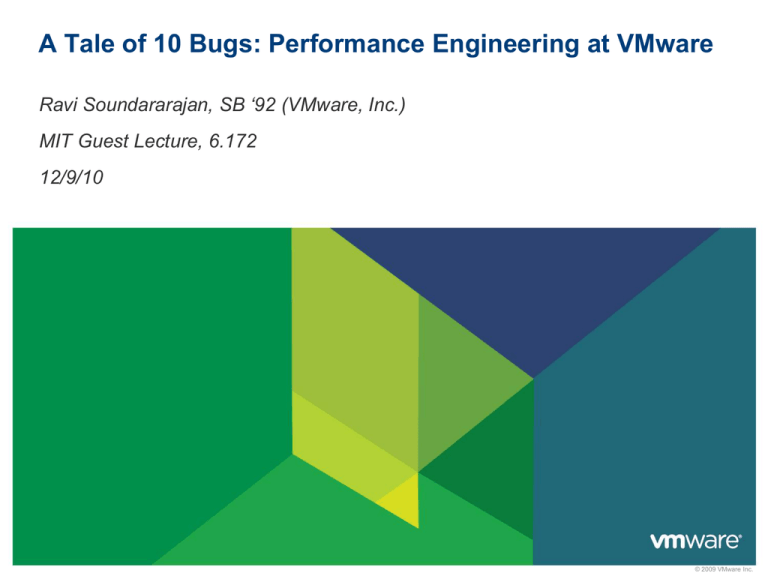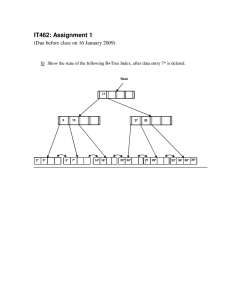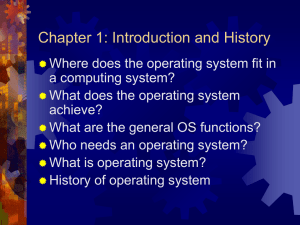
A Tale of 10 Bugs: Performance Engineering at VMware
Ravi Soundararajan, SB „92 (VMware, Inc.)
MIT Guest Lecture, 6.172
12/9/10
© 2009 VMware Inc.
A Case Study in Performance Engineering
Email thread from a colleague
“…
Interestingly, as the number of <benchmark> threads decreased
hostsPerThread var increases), the percentage of locktime spent in
dbwrites also increases.
…
lots of threads (hostsPerThread = 4):
• ~28 % lock time spent under vdbWrite Connection
• ~16 % lock time spent under exec / commit.
…”
Translation: Why is % lock time in DB increasing despite lighter load?
2
Step 0: What the ?%##!* is he talking about?
VM VM VM
DB
Agent<->HAL
3
2
Scripted Client
1
VM VM VM
Net
Agent<->HAL
Server
4
1. Client issues command to server
2. Server performs operation
3. Results persisted to DB
VM VM VM
Agent<->HAL
4. Client is notified of completion
Problem: With lighter load from client, %time spent in DB Locks increases
3
SAN
Step 1: Examine Lock Hold Time for Various Loads
Latency per lock @ 128 hosts/thread < 4 hosts/thread (Expected…lighter load)
Original question: why is %DB increasing with lighter load?
Answer: DB latency dominates when overall latency is lower!
4
Step 2: Examine Contention Time for Various Loads
Contention per lock @ 128 hosts/thread < 4 hosts/thread (OK…lighter load)
With lighter load, less overall contention time and higher % of time @ DB
5
Post mortem on Case Study #1
1. Understand experimental setup (multi-tier setup)
2. Understand what is being measured (% time in DB lock)
3. Examine relevant data (lock latency)
4. Draw appropriate conclusion
• Yes, % lock time in DB is higher with a lighter load
• BUT, overall lock time is small with lighter load
• Therefore, DB lock time (roughly constant) contributes more to lock latency
6
Outline
Case Studies in Performance Engineering @ VMware
Lessons Learned
7
Case Study #2: Garbage In, Garbage Out
Customer wants to draw this chart:
PowerCLI
• CPU Usage for a VM for last hour:
• $vm = Get-VM –Name “Foo”
• Get-Stat –Entity $vm –Realtime –Maxsample 180 –Stat
cpu.usagemhz.average
• Grab appropriate fields from output, use graphing program, etc.
8
What Happens at Scale? Comparing PowerCLI and Java
Entities
PowerCLI
Java
(cpu.usagemhz.average)
(Time in secs)
(Time in secs)
1 VM
9.2
14
6 VMs
11
14.5
39 VMs
101
16
Highly-tuned
363 VMs
2580 (43 minutes)
50
Java Stats
Collector
A Naïve script that works for small environments may not be suitable
for large environments
Translation: Garbage In, Garbage Out…but why?
9
PowerCLI vs. Java
PowerCLI
• Toolkit: meant for ease of use…hides details
• Similar to a shell script: facilitates quick prototyping
• Stateless
Java
• Harder to use
• But…can use more advanced techniques (data structures, thread pools, etc.)
10
What’s going on behind the scenes?
This is what is going on for each Get-Stat call in PowerCLI
• Retrieve PerformanceManager
• QueryPerfProviderSummary $vm Says what intervals are supported
• QueryAvailablePerfMetric $vm Describes available metrics
• QueryPerfCounter Verbose description of counters
• Create PerfQuerySpec Query specification to get the stats
• QueryPerf Get stats
Bottom line: The PowerCLI toolkit spares you details…Easy to use!
11
Optimizing the Java Code
Java
PowerCLI
perfCounter property
Of
Get VM ID
Get VM ID
for each Get-Stat {
PerformanceManager
QueryAvailablePerfMetric();
QueryAvailablePerfMetric();
QueryPerfCounter();
QueryPerfCounter();
QueryPerfProviderSummary();
QueryPerfProviderSummary();
create PerfQuerySpec();
create PerfQuerySpec();
QueryPerf();
for each Get-Stat {
}
QueryPerf();
}
PowerCLI: 5 RPC calls per VM. Java: 1 RPC call per VM.
Further optimization not shown: Java allows more compact format
12
Why Garbage In, Garbage out?
PowerCLI
• Wrote a „simple‟ but non-optimized script
• Did not utilize multi-threading (split up VM list, use muliple client queries)
• Did not realize output format is verbose
• Did not realize # of RPC calls is 5*O(#VMs)
Java
• Utilized multiple threads
• Understood what data was the same across VMs reduce redundant calls
• Utilized more compact output format (CSV vs. raw objects)
• Reduced # of RPC calls
(Think about assembly code vs. compiler-generated code)
13
Case Study #3: A Lesson in API Design
3
2
1
User wants to view
„console‟ of a VM
Clip art © source unknown. All rights
reserved. This content is excluded from our
Creative Commons license. For more
information, see http://ocw.mit.edu/fairuse.
Management server
1. User talks to management server
2. Management server locates VM
3. User & VM get connected
14
The Problem: Remote Console Doesn’t Show Up!
• Problem: could not start VM remote console in large environment
• Sequence of debugging
• Client folks: it‟s a server problem
• Server folks: it‟s a client problem
• Client folks: it‟s a „vmrc‟ problem (vmrc = VMware Remote Console)
• VMRC folks: authentication? MKS tickets?
• Me: this is ridiculous…
• More Information: Start remote console for a single VM
• 50 Hosts, no problem
• 500 Hosts, no problem
• 1001 Hosts, PROBLEM!
15
No Console: Examining the Cases the Actually Work
•Debugging observations
• With < 1000 hosts…
• Management server CPU and memory goes very high when client
invoked
• Console is dark until CPU and memory go down, then appears
• Look at server log file
• Data retrieval call occurs before console appears (WHY???)
• In failure cases, exception in serializer code
• Attach debugger
• Exception is an out-of-memory exception
• Exception is silently ignored (never returns to client)
16
No Console: Isolating the Problem
•Problem
• VMRC creates a request to monitor host information (e.g., is CD-ROM
attached)
• Request gets info on ALL hosts
• At 1001 hosts, we exceed 200MB buffer on server
• 200MB restriction only for old-style API clients
•Solution
• VMRC folks: do NOT create big request
• Server folks: fail correctly and emit better errors
Lessons
1. Create APIs that are difficult to abuse, rather than easy to abuse
2. Teach clients how to use APIs
3. Make sure (internal) users have input about API design
17
Case Study #4: 32-bit vs. 64-bit (Thanks, R. M.!)
Benchmark run
• Build A: 100 ops/min.
• Build B: 50 ops/min.
What was the difference?
• Build A: 32-bit executable on 64-bit hardware
• Build B: 64-bit executable on 64-bit hardware
Huh?
18
4 (b) xPerf
Runs on Windows 2008
Sampling profiler (with other cool attributes)
Records stack traces
Give caller/callee information
1
19
4 (c) CPU Saturation in 64-bit case
CPU is mostly saturated (in 32-bit case, CPU is not saturated)
20
4(d) Look at Sampling Profile
Shows stacks originating from root
Shows 87% CPU used from 1 process
But this is just the thread start routine, where threads originate
21
4(e) The Perils of Sampling Profilers
From Root, most of the samples are from this call stack
Most popular stack, but is this the problem?
22
4(f) Perils of Sampling Profilers, Part 2
Most-common trace: not necessarily where time is spent
Root
A1
Path A
C1
B1
Path C
Path B
A2
B2
Tiny Function
C2
Many paths to “Tiny Function‟
Maybe time spent here?
2
23
4(g) The Caller View
Look at Callers for various routines in stacks
Not called a lot from root, however…
Called from few places and takes 77% CPU!
RTtypeid?
24
4(h) RTtypeid?
Hmm. RTtypeid is used in figuring out C++ type
39% of overall CPU?
IncRef and DecRef are main callers
25
4(i) The Offending Code
void
ObjectImpl::IncRef()
{
if (_refCount.ReadInc() == 0) {
const type_info& tinfo = typeid(*this);
FirstIncRef(tinfo);
}
…
}
Dynamic cast…needs run-time type info (RTTI)
RTTI has pointers in it
26
4(j) But Why is 64-bit slower than 32-bit?
Runtime type info (RTTI) has a bunch of pointers
• 32-bit: pointers are raw 32-bit pointers
• 64-bit
Pointers are 32-bit offsets
Offsets must be added to base addr of DLL/EXE in which RTTI
resides
Result is a true 64-bit pointer
But wait…why is addition slow?
27
4(k) Why Is Addition Slow? Well, it isn’t…
Addition isn’t slow, but…
Determining module base address can be slow
• To find base address, RTtypeid calls RtlPcToFileHeader
• RtlPcToFileHeader grabs loader lock, walks list of loaded modules to
find RTTI data
• This can be slow
• N.B.: This is why we see calls to zwQueryVirtualMemory
For more info:
http://blogs.msdn.com/junfeng/archive/2006/10/17/dynamic-cast-isslow-in-x64.aspx
28
4(l) What Did We Learn?
RtTypeId is called from a bunch of places
RtTypeId is not, however, called from Root too often
RtTypeId is small and fast: not main contributor in most stacks
(except IncRef and DecRef)
Lots of little calls add up
Caller view was important here!
(btw: 2 solutions:
• 1. Statically compute base addr and cache
• 2. Use latest runtime library, which avoids RtlToPcFileHeader)
Lesson: Little things (32-bit vs. 64-bit) may matter…don’t discriminate!
29
Case Study #5: Memory Usage Woes
Why is excessive memory usage a problem?
• Can slow down application if paging is induced
• May cause application to crash (if you exceed per-process limit…2GB in 32-bit
Windows)
Memory leak vs. memory accumulation
• Leak: memory was allocated, not live anymore (dangling reference)
• Accumulation: pointer exists to data, but data not used anymore (a logical
leak)
30
Tools for Analyzing Memory Usage
Windows:
• Purify, GlowCode, Memory Validator, malloc hooks and heap dump utilities
from Microsoft, etc.
Linux:
• Valgrind, malloc hooks from Google (example: http://googperftools.sourceforge.net/), etc.
Basic idea:
• Hook calls to malloc
• Figure out liveness of pointers (do you leave scope without free()?)
• But…can be unusably slow if you do a lot of allocations!
31
A Trivial Memory Leak
void bar() {
foo();
}
void foo() {
char *p = malloc(24);
<do some computation>
return; /* memory pointed at by p is never freed */
}
32
Memory Analysis
Easing memory allocation in C++: use reference-counted objects
instead of “naked” pointers
• Each use of an item increments a reference count
• When no references exist, delete the item
• Does not solve memory accumulation problem
33
Memory Performance Problem
Server application runs out of memory after several hours
Use Purify (on a much smaller setup):
• Leak not detected because data was assigned to a reference
• Instead, examine memory in use
Do 100 iterations of an operation
See 6400B of allocations for an item (100 64B allocations)
Code inspection revealed that item was actually not used anymore…a “logical” leak
(i.e., there was a free(), but it was never called because the item was thought to be in use)
Lesson:
If an effect is small, find ways to magnify it.
34
Case Study #6: Another Memory Analysis Problem
User complains that server is getting slower and slower
CPU/network/disk not saturated
Memory, however, is increasing dramatically
Eventually, system crashes
35
Looking at Memory Usage: Perfmon in Windows
Chart of “Private Bytes” for a process vs. time
Memory growing at
alarming rate! Not
good.
Private bytes: memory
committed to process
(swap space is
allocated for it)
Memory given by OS to
app, not necessarily
memory requested by
app (example:
fragmentation)
Server is functioning fine, but memory is growing really fast.
This could lead to a crash. Let’s investigate…
36
Profiling Reference-counted Objects
Reference-counted objects
60000
50000
Pink: mutex
(286_0) Vmacore::System::MutexImpl
40000
Teal: condition variable
(232_0)
Vmacore::System::ConditionWin32
30000
(165_0)
Vmacore::System::WaitableObjectImpl
Blue: thread activation state
20000
(810_0) Vmomi::Activation
10000
0
1
70
139 208 277 346 415 484 553 622 691 760 829 898 967
Some threadrelated objects
increasing
internal threads
Hmm…number of
threads consumed is
also increasing
20
18
16
14
12
10
*** Log files show threads
being killed due to
uncaught exceptions
8
6
4
2
0
37
1
72
143
214
285
356
427
498
569
640
711
782
853
924
995
Customized Profiling: Pros and Cons
Advantages of our customized profiler:
• Tailored to our application
• Can be made very fast
• Can be run in production environments
Disadvantages:
• Requires code recompilation (then again, so does Purify)
• Specific to this application (code must be refactored for use in other apps)
• Only counts ref-counted objects: what about C code? What about non-refcounted objects?
Lesson: Memory profiling is critical.
Sad Reality: Sometimes, commercial tools don‟t work at scale
You may have to write your own
38
Case Study #7: How well do you understand networking?
User issues a request to perform an operation on a VM
• Setup A: Client/Server version 1 to host version 1: 8s
• Setup B: Client/Server version 2 to host version 1: 16s
• Consistent, repeatable difference
• Regression when using new code to talk to older host!
Step 1: Log everywhere
• Client-imposed latency: same in both cases
• Server-imposd latency: same
• Host imposed-latency: extra 8s in Setup B Focus on the host
39
Networking Issue: Analyzing the host
Step 2: More logging (standard tools aren’t available on host)
• Narrow down the time...
Agent <-> HAL, Setup A: 10ms per call
Agent <-> HAL, Setup B: 200ms per call
Wow!
Step 3: Examine configuration
• Setup A: named pipe between Agent and HAL
• Setup B: TCP/IP connection between Agent and HAL
40
Networking Issue: Resolution
Step 4: Solution (intuition by developer)
• Named pipe communication, setup A: 10ms
• TCP/IP communication, setup B: 200ms
• Why? Nagle algorithm on socket connection
On a TCP socket, wait for more data before sending packets
Can be disabled through TCP_NODELAY option
Step 5: Result
• Use TCP_NODELAY, both have same performance
• Eventually use a cache to avoid interprocess communication
Lesson?
• “Little” changes can mean a lot
• Client/server code: understand the client/server interaction!
41
Case Study #8: Correctness Impacts Performance
Trying to Power on a VM
• Sometimes, powering on VM would take 5 seconds
• Other times, powering on VM would take 5 minutes!
Where to begin?
• Powering on a VM requires disk activity on host Check disk metrics for host
42
Examining Disk Latencies…
Rule of thumb:
latency > 20ms is
Bad.
Here:
1,100ms
REALLY BAD!!!
Chart shows highest disk latency for each 5-minute period
Max Disk Latencies range from 100ms to 1100ms…very high! Why?
43
High Disk Latency: Mystery Solved
Host events: disk has connectivity issues high latencies!
Bottom line: correctness issue (bad disk controller) impacts
performance!
44
Prelude to Case Studies 9 & 10: CPU Scheduling for VMs
Wait/Idle
VM1
VM5
VM6
VM4
VM0
VM1
VM4
VM2
VM3
CPU
0
CPU
1
CPU
2
CPU
3
Ready
Run
ESX
Run (accumulating used time)
Ready (wants to run, no physical CPU available)
Wait: blocked on I/O or voluntarily descheduled
45
Case Study 9: “But it’s only a small probe VM…”
ODBC
Sniffs
Clip art © source unknown. All rights
reserved. This content is excluded
from our Creative Commons license.
For more information, see
http://ocw.mit.edu/fairuse.
Traffic
vSphere
VM
Probe VM
ESX 1
vSphere
DB
ESX 2
vSphere communicates with DB
Probe VM monitors vSphere-to-DB traffic
The more traffic, the more work done by Probe VM
User Complaint: vSphere VM is suddenly very unresponsive
46
CPU Usage vs. Time for DB and Probe VM
Lesson: Understand the
Implications of Monitoring
DB VM ready time goes from 12.5% when idle to ~20% when user busy
DB ready time increases because Probe VM is busy
Probe VM takes CPU away from DB VM user responsiveness suffers
47
Case Study #10: What Does This Metric Mean?
Problem
• Customer Performs a Load Test: keeps attaching clients to a server
• At some point, CPU is NOT saturated, but latency starts to degrade
• At some point, client is unusable
• Why?
48
“Oh yeah, it’s a disk problem…”
CPU Usage Increases…
Uh-oh! Disk Latencies go over a cliff!
49
Hmm. Not So Fast!!!
Problem:
Yes, Disk Latency gets worse at 4pm. (btw…due to swapping)
However, Application latency gets worse at 3:30pm!
What’s going on from 3:30pm to 4pm?
50
Looking at a different chart…
vm1
vm2
vm3
vm4
%Used? %Run? What‟s the difference?
Lesson: understand
%used: normalized to base clock frequency
your metrics!
%run: normalized to clock frequency while VM is running…
%run > %used: Power Management is kicking in…
In this case, turn off power managementlatency problems go away
51
The 10 Performance Issues I Mentioned
1. DB Lock % increase with decreasing load
• Be careful when you draw conclusions…
2. PowerCLI vs. Java
• Garbage-In, Garbage-Out: scalable solutions require careful design
3. Remote Console Issues
• Create APIs that are easy to use and difficult to abuse
4. 32-bit vs. 64-bit
• A small change can make a HUGE difference
5. “Logical” leak
• Just because you do “new/delete,” doesn‟t mean memory won‟t grow (btw.,
Java doesn‟t save you!)
• Exaggerate a problem to make it easier to find the root cause
52
The 10 Performance Issues I Mentioned
6. Slow memory growth until crash
• Sometimes you need customized profilers
7. Nagling
• Understand client/server interactions
8. Disk Latency
• Correctness Impacts Performance
9. Probe VM activity hurting performance of other VMs
• Understand the Impact of Monitoring
10. Power Management affecting Performance
• Understand your metrics & consider the whole system
53
Conclusion: Tips for Performance Engineering
Avoid assumptions! (see #10)
Understand the ENTIRE SYSTEM
• Your code
• Other people‟s code
• Hardware
Be persistent and thorough
• Look at tons of metrics
• Look at behavior when things work as well as when they don‟t work
54
MIT OpenCourseWare
http://ocw.mit.edu
6.172 Performance Engineering of Software Systems
Fall 2010
For information about citing these materials or our Terms of Use, visit: http://ocw.mit.edu/terms.








